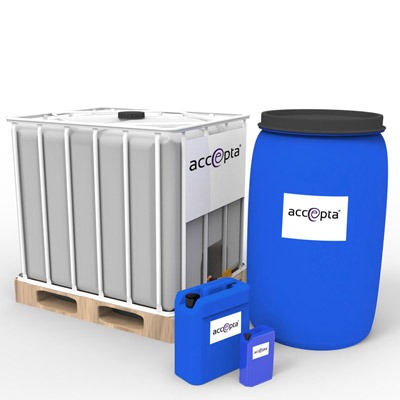FD-BROM / AT-2343 – Adjunct for Generating Hypobromous Acid
- Home
- Water Treatment Chemicals
- Biocides & Disinfectants
- FD-BROM / AT-2343 – Adjunct for Generating Hypobromous Acid
£152.00 ex. VAT
Quantity discount tiers
5-8
17%
DISCOUNT
9-16
25%
DISCOUNT
17-31
30%
DISCOUNT
32+
33%
DISCOUNT
Prices are for 25Kg Drums/Kegs. POA for 200kg/IBCs.
Use Accepta Activator 120 as an activator for this product.
Description
FD-BROM / AT-2343 is scientifically formulated for use in conjunction with a chlorine donor such as Accepta Activator 120 or sodium hypochlorite to generate hypobromous acid (Bromine).
Hypobromous acid is a powerful oxidising microbiocide for use in cooling towers, cooling water systems and other related systems to control the growth of bacteria, algae and fungi.
This treatment approach is effective over a wide range of pH and is an excellent supplement to other corrective treatment procedures.
FD-BROM / AT-2343 contains a blend of non-ionic surfactants to aid the penetration and dispersion of biofilms.
Product Benefits
- High performance biocidal adjunct used for generating hypobromous acid.
- Effective at low concentrations
- Effective at high pH
- Controls a wide spectrum of bacteria, algae and fungi
- Simple to control
- Will inhibit formation of biofilms
Product Properties
| Appearance: | Colourless to brown solution |
| Odour: | Negligible |
| Flammability: | Non-flammable |
| pH: | 5 – 9 |
| Relative Density: | 1.14 |
| Solubility in water: | Complete |
*Full details of the product properties are available in the Safety Data Sheet. See below.
Application & Dosage Information
FD-BROM / AT-2343 must be applied in combination with sodium hypochlorite in a specific mixing/dosing unit. The resultant mixture can be added directly to the tower sump or any other convenient point in the system. We will advise on the selection of the correct mixing/dosing equipment.
For simplicity FD-BROM / AT-2343 is designed to be dosed at the same volumetric rate as Accepta Activator 120.
For full details concerning safety precautions, storage and handling procedures for this product please refer to the latest Safety Data Sheet.
To request the latest MSDS for this product please fill out the form below.
Additional information
| Weight | 25 kg |
|---|---|
| Dimensions | 30 × 23 × 47 cm |
Description
FD-BROM / AT-2343 is scientifically formulated for use in conjunction with a chlorine donor such as Accepta Activator 120 or sodium hypochlorite to generate hypobromous acid (Bromine).
Hypobromous acid is a powerful oxidising microbiocide for use in cooling towers, cooling water systems and other related systems to control the growth of bacteria, algae and fungi.
This treatment approach is effective over a wide range of pH and is an excellent supplement to other corrective treatment procedures.
FD-BROM / AT-2343 contains a blend of non-ionic surfactants to aid the penetration and dispersion of biofilms.
Product Benefits
- High performance biocidal adjunct used for generating hypobromous acid.
- Effective at low concentrations
- Effective at high pH
- Controls a wide spectrum of bacteria, algae and fungi
- Simple to control
- Will inhibit formation of biofilms
Product Properties
| Appearance: | Colourless to brown solution |
| Odour: | Negligible |
| Flammability: | Non-flammable |
| pH: | 5 – 9 |
| Relative Density: | 1.14 |
| Solubility in water: | Complete |
*Full details of the product properties are available in the Safety Data Sheet. See below.
Application & Dosage Information
FD-BROM / AT-2343 must be applied in combination with sodium hypochlorite in a specific mixing/dosing unit. The resultant mixture can be added directly to the tower sump or any other convenient point in the system. We will advise on the selection of the correct mixing/dosing equipment.
For simplicity FD-BROM / AT-2343 is designed to be dosed at the same volumetric rate as Accepta Activator 120.
For full details concerning safety precautions, storage and handling procedures for this product please refer to the latest Safety Data Sheet.
To request the latest MSDS for this product please fill out the form below.
Additional information
| Weight | 25 kg |
|---|---|
| Dimensions | 30 × 23 × 47 cm |
Data Sheets & enquires
To request the safety or technical data sheets on this product or simply enquire further about chemical supply please fill out this contact form.
Contact us
Please complete this form and we will be in touch
